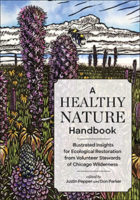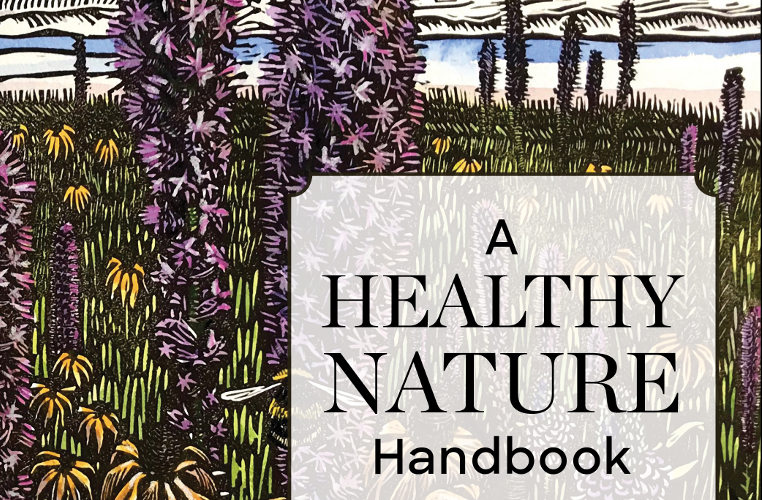 From A Healthy Nature Handbook edited by Justin Pepper and Don Parker. Copyright © 2021 Bobolink Foundation. Reproduced by permission of Island Press, Washington, D.C. The excerpt is taken from the Chapter: The Society of Stewardship with Stephen Packard, Linda Masters, and Eriko Kojima pages 125 – 127.
From A Healthy Nature Handbook edited by Justin Pepper and Don Parker. Copyright © 2021 Bobolink Foundation. Reproduced by permission of Island Press, Washington, D.C. The excerpt is taken from the Chapter: The Society of Stewardship with Stephen Packard, Linda Masters, and Eriko Kojima pages 125 – 127.
“We want diversity of people, not only the biodiversity in the ecosystem,” says Eriko. “Ethnic or racial, religious diversity, but also diversity of ages, life stages, educational levels, everything. We don’t want to just aim for a sweet spot of younger people or retired people. Any organization or organism is more robust when you’ve got diversity.”
Building a large roster of people in many different situations — both active volunteers and those in the “reserves” — has paid off for the longest-lasting volunteer groups.
“I think that a lot of the younger people who are not committing yet, maybe in the end when they’re in a more stable time in their life, will be stewards,” says Eriko. “And it might take years. Just like Rob Sulski, right? Took him 20 years to start growing plants. So it just incubates in your heart. You know, you just have this nice feeling about it and this commitment at the level that you can at that time.”
Assemble a Tribe of Doers
Just like in a hunter-gatherer group, specialization and complementary skills are key to effectiveness — and even survival.
Stephen has spent a long time considering teamwork in restoration.
“Think of these groups as hunter-gatherer groups,” he says. “We humans, we have very different strengths from person to person. Somebody is good at math; somebody is good at geography — they know how to get from place to place; we have people who are physically good hunters; we have people who nurture stuff, growing little things; we have people who help the group process. And we need them all.”
Some skills are indispensable.
“Inspiring people to know the plants is just a key thing,” says Stephen. “And you don’t have to learn everything, but you have to get excited about starting to learn.”
Having leaders with basic restoration experience is critical too. Focusing on a specialty may help volunteers develop expertise faster.
“If there are three of you,” says Stephen, “maybe one person learns the plants, one person learns herbicide and forestry techniques, and the other one learns seeds. In one person, or in a number of people, you need all this stuff.”
But having technical or “hard skills” isn’t enough.
“There are people in all the stewardship groups who are technically good, and that alone doesn’t do it,” says Stephen. “Now there are also people who are the mom or the dad of the group, and help people get along with each other, and maintain the spirit, etcetera, which is critical…. A lot of times, there’s sort of a social person who ends up being the principal glue for the larger group.”
Success hinges in large part around empowering volunteers — supporting them, but mostly getting out of their way.
“A lot of this is dependent on independent people who have independent ideas,” says Stephen. “Our first person along these lines was Preston Spinx, who decided to grow rows of rare prairie plants between his beans and cabbages in his little garden in his Morton Grove backyard. The Botanic Garden couldn’t get hoary puccoon to grow, but he could get it to grow because he just gave it a lot of attention…. And he did that with a bunch of plants.”
Another case of specialization in the North Branch was Gail Schmoller.
“She was not a workday type — she was much more of a high heels and fancy clothes type. But she had decided that she would like to create a career for herself as a public relations person. And she said, ‘I’ve been reading about you in the paper. Could I publicize you, to gain experience and get contacts and demonstrate that I’m good at it?’ So she adopted us.… And a huge portion of our success came from Gail Schmoller getting us into the media all the time.”
A diverse group can mean fresh ideas that move a group forward, says Linda.
“Somebody will come in and be oblivious to all the politics and say, ‘I’ve got this great idea, and I’m just gonna do it!’ And they’ll do it, and the fallout will happen, and it’ll be a success.” Many worthy projects happen this way, she says. “It really needs that spark-plug person to grab a hold of it.”
There’s a role for every member to play, says Stephen.
“There are people who, for example, have kids or they’ve gotten older, and they just can’t get out of the house as much, but they would love to do something from home.”
Sometimes all it takes to fill the holes and round out your group is to make it known there’s a need.
“One thing we don’t do enough is to get that list of who’s doing what and what’s needed out widely very often,” says Stephen, “which would be a good thing for us to do.”





